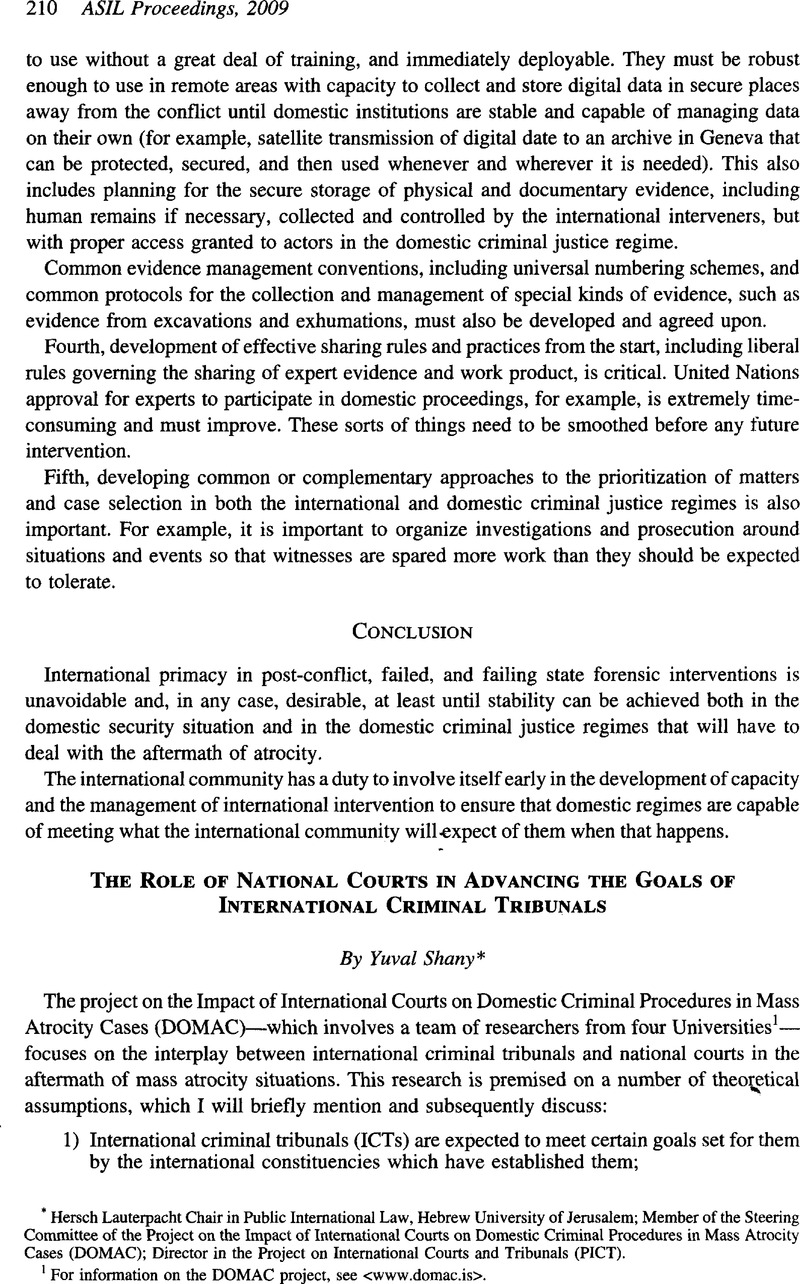No CrossRef data available.
Article contents
The Role of National Courts in Advancing the Goals of International Criminal Tribunals
Published online by Cambridge University Press: 28 February 2017
Abstract

- Type
- The Impact of International Criminal Proceedings on National Prosecutions in Mass Atrocity Cases
- Information
- Copyright
- Copyright © American Society of International Law 2009
References
1 For information on the DOMAC project, see <www.domac.is>.
2 See, e.g.. Expert Group, Report of the Expert Group to Conduct a Review of the Effective Operation and Functioning of the International Tribunal for the Former Yugoslavia and the International Criminal Tribunal for Rwanda, U.N. Doc. A/54/634, at ¶ 92 (Nov. 22, 1999); Alvarez, Jose E. Crimes of States/Crimes of Hate: Lessons from Rwanda, 24 Yale J. Int’l L. 365, 414 (1999)Google Scholar.
3 See Mundis, Daryl A. The Judicial Effects of the “Completion Strategies “ on the Ad Hoc International Criminal Tribunals, 99 A.J.I.L. 142 (2005)Google Scholar.
4 See generally, Internationalized Criminal Courts and Tribunals: Sierra Leone, East Timor, Kosovo, and Cambodia (Cesare P.R. Romano et al. eds., 2004).
5 See, e.g., Rome Statute of the International Criminal Court, July 17, 1998, preamble, 2187 U.N.T.S. 90 (hereinafter Rome Statute)(“Determined to put an end to impunity for the perpetrators of these crimes and thus to contribute to the prevention of such crimes”); UN Doc. S/RES/827 (May 25, 1993), preamble (hereinafter SC Res. 827)(“Determined to put an end to such crimes and to take effective measures to bring to justice the persons who are responsible for them”).
6 But see Rome Statute, supra note 5, art. 75.
7 See, e.g., SC Res. 827, supra note 5, preamble (“Convinced that in the particular circumstances of the former Yugoslavia the establishment as an ad hoc measure by the Council of an international tribunal and the prosecution of persons responsible for serious violations of international humanitarian law would enable this aim to be achieved and would contribute to the restoration and maintenance of peace”); UN Doc. S/RES/955 (Nov. 8, 1994), preamble (“Convinced that in the particular circumstances of Rwanda, the prosecution of persons responsible for serious violations of international humanitarian law would enable this aim to be achieved and would contribute to the process of national reconciliation and to the restoration and maintenance of peace “).
8 See, e.g., Cameron, Iain, Jurisdiction and Admissibility Under the ICC Statute, The Permanent International Criminal Court 65, 93 (McGoldrick, Dominic et al. eds., 2004)Google Scholar.
9 See, e.g., William Schabas, The UN International Criminal Tribunals 17 (2006).
10 See, e.g., William Schabas, War Crimes and Human Rights: Essays on the Death Penalty, Justice and Accountability 379 (2008).
11 See, e.g., Baylis, Elena, Reassessing the Role of International Criminal Law: Rebuilding National Courts through Transnational Networks, 50 B. C. L. Rev. 1, 12-13 (2009)Google Scholar.
12 See, e.g., Prosecutor v. Munyakazi (Case No. ICTR-97-36-Rllbis), ICTR AC Decision of Oct. 8, 2008.
13 See Keren Michaeli, DOMAC Report on Croatia (2009), available at www.domac.is.
14 Law No 11/2007 of 16/03/2007, Organic Law Concerning Transfer of Cases to the Republic of Rwanda from the International Criminal Tribunal for Rwanda and from other States, available at http://www.unhcr.org/refworld/pdfia7476644652.pdf.
15 See Sigall Horowitz, DOMAC Report on Sierra Leone (2010), available at www.domac.is.


